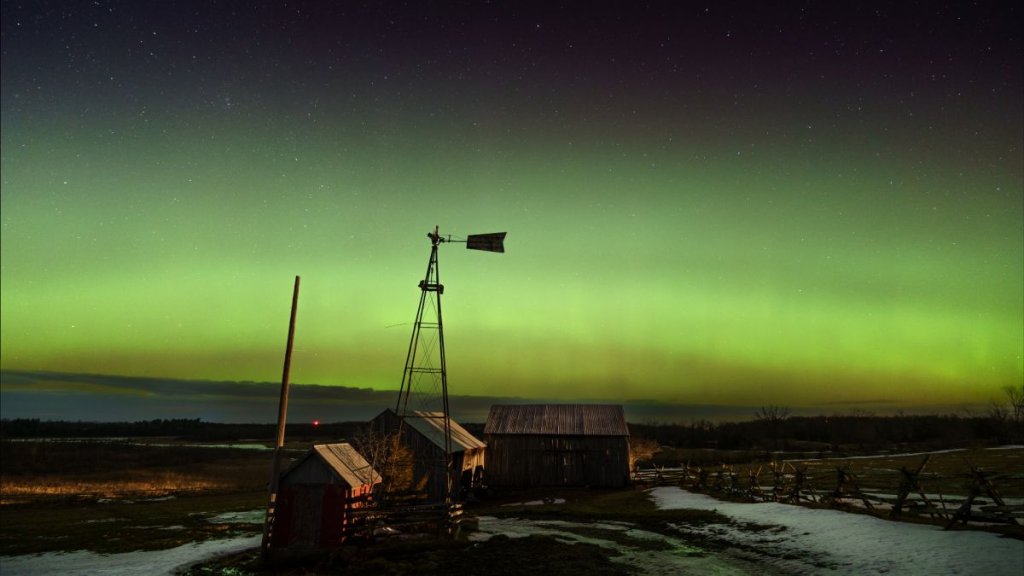
Strongest solar storm in nearly 6 years slams into Earth catching forecasters by surprise (Image Credit: Space.com)
The most powerful solar storm in nearly six years slammed Earth today (March 24), but strangely, space weather forecasters didn’t see it coming.
The geomagnetic storm peaked as a severe G4 on the 5-grade scale used by the U.S. National Oceanic and Atmospheric Administration (NOAA) to assess the severity of space weather events. The storm’s unexpected ferocity not only made auroras visible as far south as New Mexico in the U.S., but it also forced spaceflight company Rocket Lab to delay a launch by 90 minutes.
Geomagnetic storms are disturbances to Earth’s magnetic field caused by solar material from coronal mass ejections (CME) — large expulsions of plasma and magnetic field from the sun’s atmosphere. It turns out that this particular geomagnetic storm was triggered by a “stealth” CME which — as the name suggests — is rather tricky to detect.
Related: Huge solar tornado as tall as 14 Earths hurls plasma cloud into space. Here’s the video.
NOAA’s National Space Weather Service originally announced a “geomagnetic storm watch” on March 22 (opens in new tab), to come into effect on 23-25 March with possible moderate G2 storm conditions expected on March 24. So forecasters weren’t completely caught off-guard, they however didn’t expect a magnitude G4 storm.
It wasn’t until 00:41 a.m. EDT ( 0441 GMT) on March 24 that NOAA uprated the warning to a severe G4 storm, which was after a stronger than forecasted G3 storm (opens in new tab)escalated to a G4 at 12:04 a.m. EDT (0404 GMT).

(opens in new tab)
U.S. space weather forecaster Tamitha Skov explained to Space.com in an email why the space weather community got it so wrong with this latest storm.
“These nearly invisible storms launch much more slowly than eruptive CMEs and are very difficult to observe leaving the sun‘s surface without specialized training,” she said, adding that the stealth CMEs can also be “camouflaged” by other, more dense structures emanating from the sun, which makes them difficult to observe.
“This is why they are the cause of “problem geomagnetic storms” like the G4-level storm we are in now.” Skov continued.
You can learn more about these stealthy solar storms in Skov’s latest YouTube video (opens in new tab) where she describes the space weather event in more detail.
NOAA (opens in new tab) ranks geomagnetic storms on a scale running from G1, which could cause an increase in auroral activity around the poles and minor fluctuations in power supplies, up to G5, which includes extreme cases like the Carrington Event — a colossal solar storm that occurred September 1859, which disrupted telegraph services all over the world and triggered auroras so bright and powerful that they were visible as far south as the Bahamas.
Strong geomagnetic storms can be troublesome for spaceflight as they increase the density of gases in Earth’s upper atmosphere, thereby increasing the drag on satellites and other spacecraft. In February 2022 SpaceX lost up to 40 brand-new Starlink satellites when they failed to reach orbit after being launched into a minor geomagnetic storm.
Rocket Lab delayed its launch this morning by approximately 90 minutes while assessing the evolving conditions (opens in new tab) of the geomagnetic storm, the company announced on Twitter. They successfully launched at 5:14 a.m. EDT (0914 GMT).
Another side effect of powerful geomagnetic storms is the incredible aurora displays they trigger. When energized particles from the sun slam into Earth’s atmosphere at speeds of up to 45 million mph (72 million kph), our planet’s magnetic field funnels the particles toward the poles. The ensuing supercharging of molecules in Earth’s atmosphere triggers the colorful spectacles, which usually remain limited to areas at high latitudes. This time, skywatchers around the world were treated to a dazzling auroral display that reached as far south as Colorado and New Mexico.
We can expect more extreme space weather events like this powerful geomagnetic storm as the sun builds towards a peak in its 11-year solar activity cycle, expected to occur in 2025.





